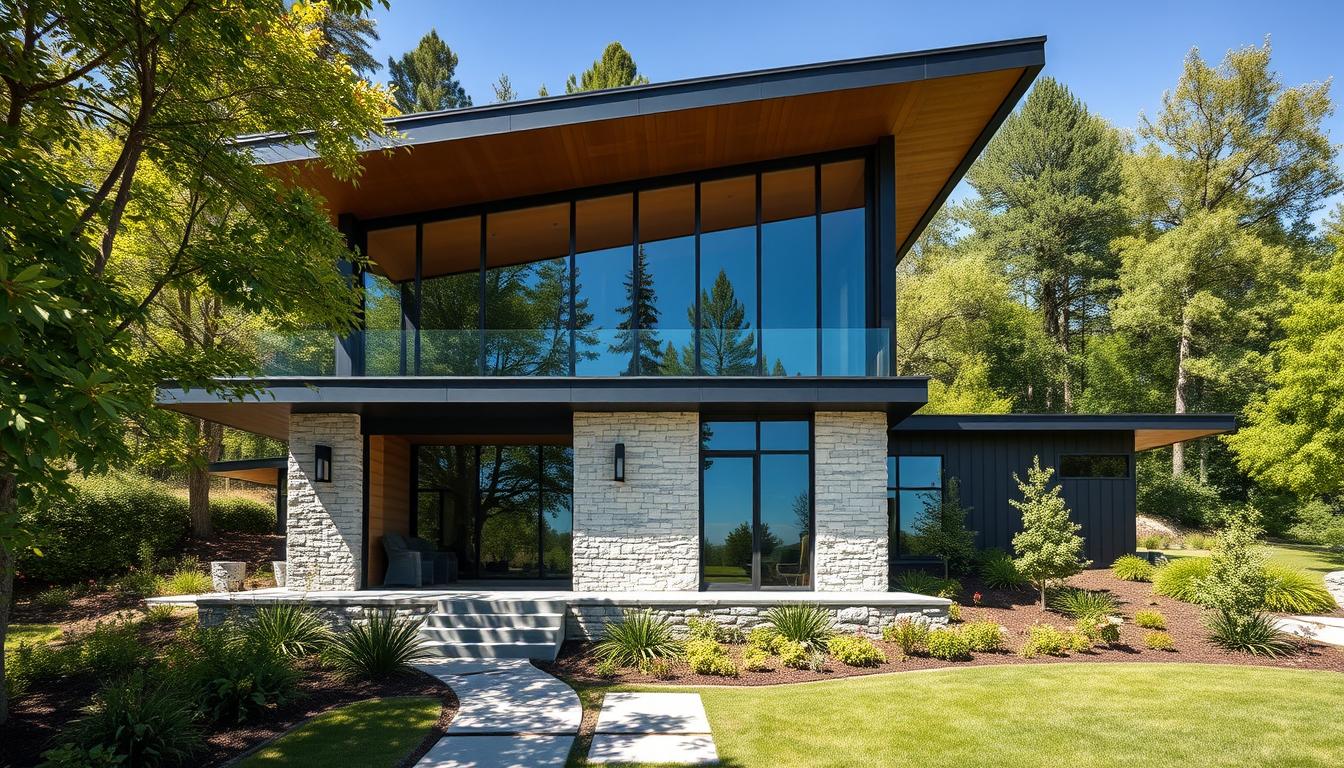Ever wonder if a single spark could damage your dream home? This guide shows how to make a fire-resistant house that’s safe and cozy for years. You can have a strong, safe home without spending too much or losing style.
Clay bricks can withstand temperatures up to 1,200°C and resist pests. Wildfires often target unprotected areas. So, building a fireproof home keeps your family safe and saves you time.
Choosing the right materials, smart landscaping, and sealed doors create a strong defense. Each part fits your style perfectly. This way, you get a safe, energy-saving home that lasts.
Key Takeaways
- Clay bricks can handle extreme heat, adding long-lasting defense.
- Ember attacks sneak through tiny gaps during wildfires.
- Sealed points and vetted vents block dangerous embers.
- Flame retardant property designs cut down on surprise emergencies.
- Low-maintenance choices save time and boost fire safety features.
- Sturdy construction merges style with total peace of mind.
Understanding Fire Risks and Building Codes
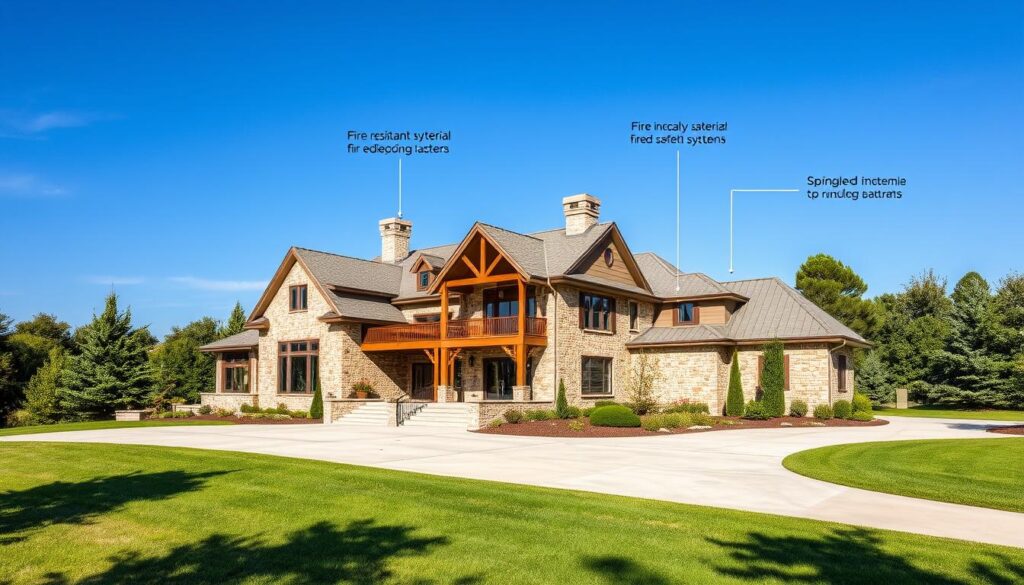
Building a lasting home means being careful about unexpected dangers. Fires can start near foundations or rooftops, which is a big risk in areas with dry plants. Homeowners who focus on fire safety early on feel more secure. This is because local rules focus on making buildings strong.
Why Fire Awareness Matters for Home Construction
Using fire-resistant materials can lower the risk of fires. Debris from fires often lands on rooftops, increasing the risk by 20%. Class A-rated roofs help keep embers out, which is crucial for fire safety.
About 60% of wildfires start close to houses, showing the importance of a clear area around homes. This area should be free of dry plants.
Key Building Regulations to Keep in Mind
In California, buildings must have Class A roofs to be fire-safe. This helps prevent fires from spreading. Upgraded vents also help keep embers out of attics.
Many places require homes to have a clear area around them. This follows new rules to keep neighborhoods safe. Builders who think about fire safety early on save money and get better insurance deals.
- Class A-rated roofs reduce ignition rates by up to tenfold
- Defensible space limits wildfire spread
- Low-maintenance exteriors help meet local fire safety standards
| Code Requirement | Focus | Benefit |
|---|---|---|
| Class A Roofing | Noncombustible layering | Less risk of debris-induced ignition |
| Defensible Space | Clear zones near structures | Prevents embers from latching on |
| Vent Upgrades | Ember-resistant mesh | Stops flying sparks |
How to Build a Fireproof Home from the Ground Up
Many families face risks when building near wildfire zones. Between 1990 and 2003, over 11,055 homes were burned in California. This highlights the need for strong design strategies.
A fire-resistant house starts with a solid foundation and clear areas around it. Reinforced walls and sealed doors help prevent embers from causing damage.
Using noncombustible roofing materials boosts safety. These materials can get a “Class A” rating if they withstand flames for 90 minutes. An 8-inch ICF wall can resist fire longer than wood, reducing damage risk.
Most homes catch fire from small flames or embers. Keeping vegetation trimmed and storing combustibles away from the house is crucial. This ensures a fire-safe dwelling.
Exploring energy-efficient solutions is also wise. Check out this guide for innovations that enhance fire protection for homes.
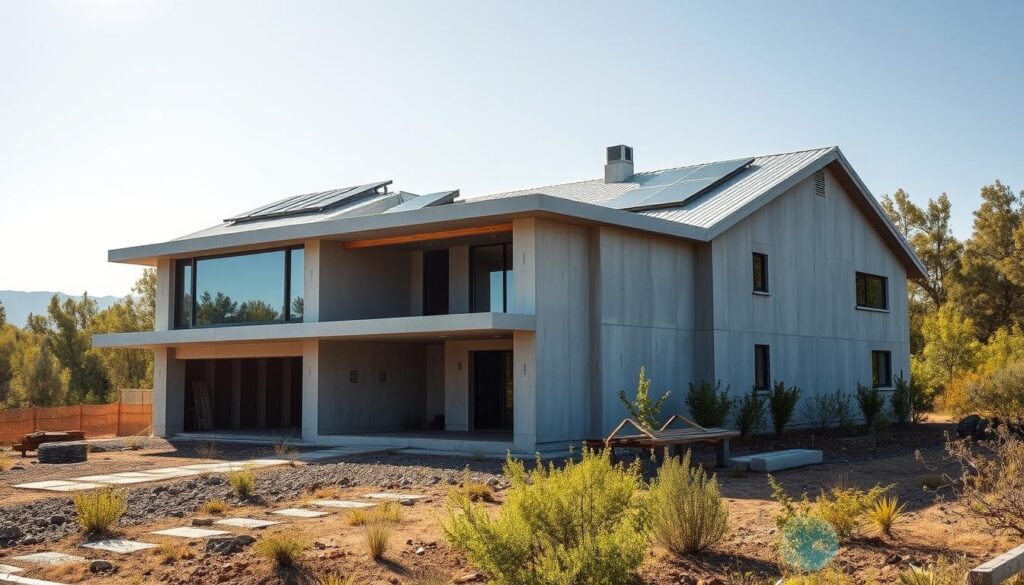
- Clear flammable fuels in a 30-foot radius.
- Choose noncombustible roofing with a high fire rating.
- Install vents with small metal mesh to deter embers.
| Material | Fire Rating | Key Benefit |
|---|---|---|
| ICF (8″) | 4 Hours | Superior fire resistance |
| Metal Roof | Class A | Long lifespan, high durability |
| Composite Siding | Varies by Brand | Flame retardant and stylish |
Selecting Fire-Resistant Materials for Foundations and Walls
Building a fireproof house begins with strong walls and foundations. Homeowners often choose materials like advanced concrete and durable bricks for safety. These options are key to a sturdy home.
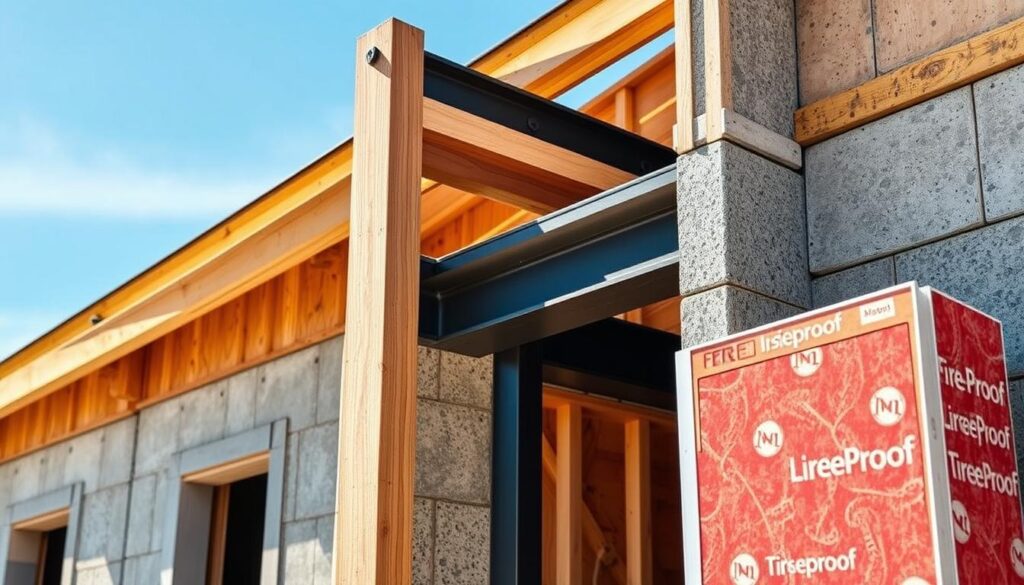
The SAM House in Sacramento shows the power of 12,000 psi concrete. It can withstand flames and strong winds. This material can last up to 200 years and is non-flammable.
Full-wall brick installations also play a big role. They fight off termites and keep property values high.
Best Practices for Choosing Flame-Retardant Concrete and Bricks
Insulated Concrete Forms (ICFs) can block fire for up to four hours. They are only 1%–4% more expensive than wood frames. This upgrade is crucial for a fireproof home.
Importance of Fire-Resistant Insulation
Using mineral wool or foam insulation is key. They slow down heat and stop fires from spreading. This keeps your home safe and strong.
Cost and Durability Considerations
Fire-resistant materials might cost more upfront. But, many insurers offer lower premiums for these homes. This makes the investment worthwhile and attractive financially.
| Material | Approximate Fire Resistance | Cost Range |
|---|---|---|
| High-Strength Concrete (SAM House) | Non-Flammable | $400K–$1M |
| Full-Brick Walls | High Resistance | Varies by Region |
| ICFs | Up to 4 Hours | 1%–4% More Than Wood-Frame |
Roofing and Insulation: Ensuring a Flame-Retardant Property
Fiberglass-based asphalt shingles are used in 80% of U.S. homes. CertainTeed’s Highland Slate is Class A rated and looks like natural slate. EcoStar’s Majestic Slate tiles are Class C rated and made from recycled materials. They are great for those on a budget who want protection against fire.
Metal roofing can get a Class A rating with fire-resistant underlayment. They come with warranties from 30 to 50 years. Clay tiles are noncombustible and keep homes cool, lasting longer than many other materials.
Choosing the right roofing is key to a fireproof home. Clay tiles are noncombustible and keep homes cool. Metal or slate roofs work well with insulation for extra protection. Regular maintenance, like cleaning gutters, is important.
Insulation under the roof deck helps keep heat out. This makes a house safe and energy-efficient. Keeping gutters clean and checking for debris can lower fire risk.
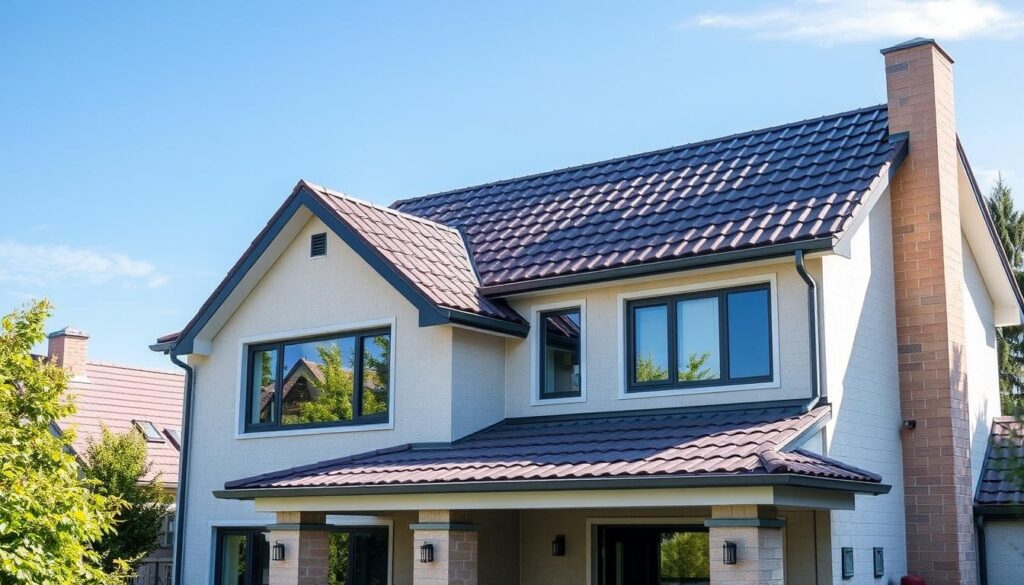
| Type | Fire Rating | Key Benefit | Example Brand |
|---|---|---|---|
| Fiberglass Asphalt Shingles | Class A | Affordable, widely used | CertainTeed Highland Slate |
| Metal Roofing | Class A (with underlayment) | High durability, 30–50 year warranty | Various Manufacturers |
| Clay Tiles | Noncombustible | Excellent insulation, long lifespan | Multiple Suppliers |
| EcoStar Slate Tiles | Class C | 80% recycled content, eco-friendly | EcoStar Majestic Slate |
Fire-Safe Windows, Doors, and Vents
Fire openings are a big threat to many homes, where flames and embers can strike without warning. Upgrading windows, doors, and vents is a smart move to make a house fire safe. This is crucial for those trying to build fireproof houses in risky areas.
“The National Fire Protection Association reports that homes with smoke detectors reduce the risk of dying in a fire by 55% compared to residences without alarms.”
Choosing Glass and Frame Materials for Fire Resistance
Double-paned, tempered glass acts as a strong barrier against heat and burning cinders. Frames made of steel or fire-rated composites add extra protection. This is essential for making a house fire resistant, even with big windows.
Ventilation Systems That Minimize Fire Spread
Vent openings should have tight metal mesh to stop embers from spreading. Doors with air gaps need strong gaskets to keep sparks out. These steps help in fire proofing a house, giving more time for evacuation and help from experts. They also show how to stop fires from getting worse.
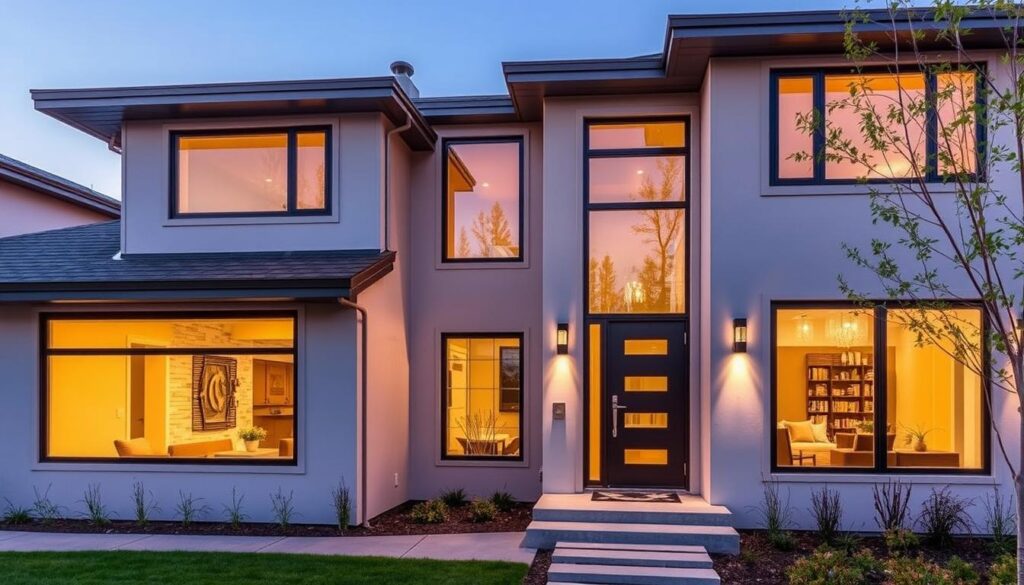
Strong vents and fortified windows keep people safe in disaster-prone states. It’s part of a bigger plan to lower property losses and make communities stronger.
Implementing Fireproofing Solutions in Interior Design
Interior elements are crucial in creating a fireproof home. Walls and floors with strong finishes are key. They help achieve your fire-resistant home goals. Surface treatments are vital in designing a fireproof house that’s safe and stylish.
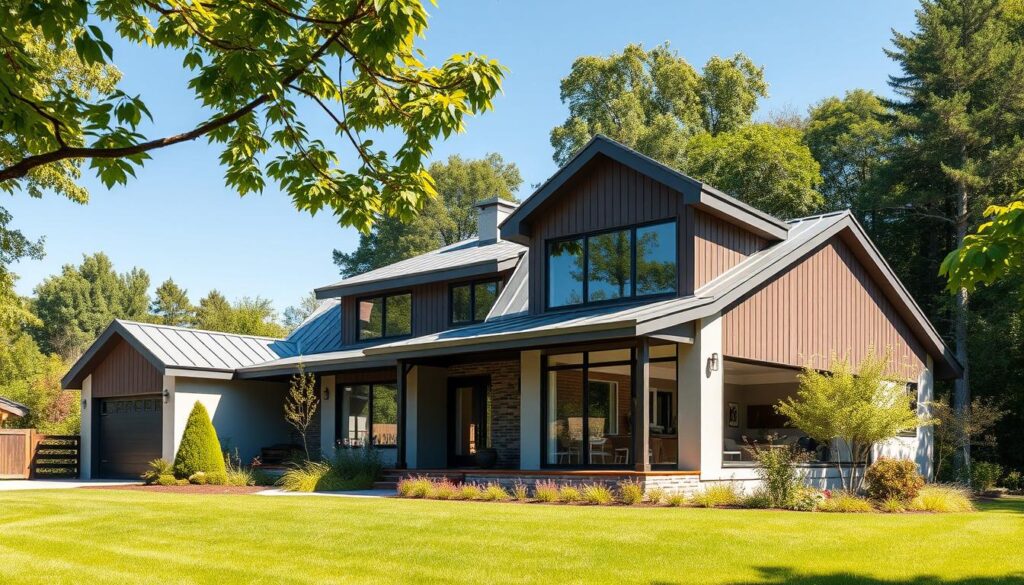
Good design choices can make cleanup easier and slow down fire spread. A fire-resistant home often uses tile, polished concrete, or treated hardwood. These materials delay combustion.
Fire-Resistant Paints, Finishes, and Flooring
Special paints slow down burning surfaces, reducing heat spread. Some varnishes and coatings add extra protection. They help floors or furniture resist ignition. These choices meet safety standards while enhancing your décor.
Upholstery and Drapery Choices for Safety
Flame-retardant fabrics reduce the risk of sudden fires. Sofas, curtains, and rugs can have treated fibers. These fibers block fire spread. This keeps living areas safe without losing comfort or style.
Secure storage is also important for home safety. Fireproof safes protect documents and valuables from heat. Here’s a quick overview:
| Fire Rating | Number of Options | Brands Mentioned |
|---|---|---|
| 30 Minutes | 1 | Hollon, Fort Knox, Browning |
| 1 Hour | 9 | Browning, Hollon |
| 90 Minutes | 10 | Fort Knox, Browning |
| 2 Hours | 54 | Hollon, Fort Knox |
Landscaping for a Fire-Resistant House Exterior
Good yard design is key in making a house fireproof. It keeps flames away from important parts of the house and looks good. By spacing plants right, you lower the risk of fire spreading from one plant to another.
Choosing easy-to-care-for options like stone paths and gravel borders is smart. They offer strong protection and show the way to a fire-safe home.
In 2023, over 330,000 homes caught fire, says the National Fire Protection Agency. This shows how important a fire-safe yard is. Start by removing dried leaves, trimming tall plants, and clearing brush. This creates a safe barrier. Check out this innovative home-building company for more ideas.

- Use drought-tolerant plants that resist ignition.
- Create hardscapes to form firebreaks.
- Keep trees trimmed and distance them from your home.
- Remove flammable debris around decks and patios.
These steps help make your home fireproof. They cut down on fuel sources and protect walls and roofs from heat. A well-designed yard adds extra protection against embers and flames.
| Landscaping Option | Key Benefits |
|---|---|
| Drought-Resistant Plants | Conserve water, lower chances of quick ignition |
| Hardscaped Surfaces | Block fire paths and need minimal upkeep |
| Gravel or Stone Borders | Create fuel breaks and reduce weed growth |
Electrical Safety Measures to Prevent Household Fires
Keeping wiring updated is crucial for a fireproof house. Old or damaged connections can spark and hide dangers behind walls. Modern systems boost performance and lower fire risks.
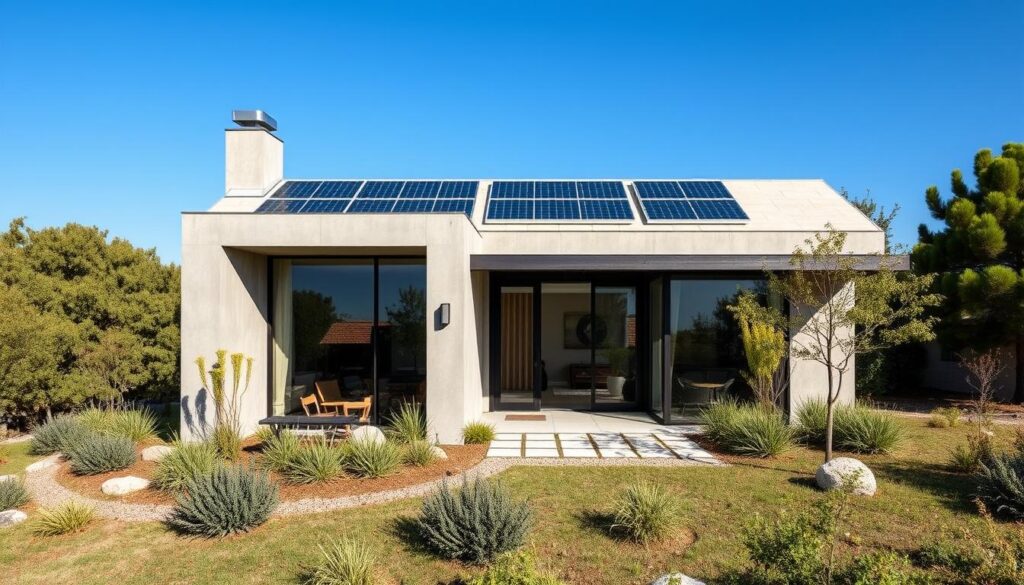
Smart outlets and GFCIs add security. They cut off power if something’s wrong, making your home safer. Regular checks by a licensed electrician keep your system up to date, vital for fire safety.
Upgrading Wiring and Outlets
Older homes may not handle today’s devices well. Upgrading outlets stops overloading and extends appliance life. Advanced breakers and strong wiring manage power, protecting your fireproof home.
New electrical tech helps prevent fires from short circuits. Investing in these upgrades keeps your home stable and safe for years.
Routine Inspections and Maintenance for Long-Lasting Fire Resistance
Keeping fire resistant homes safe requires planning and regular checks. Walls, seals, and fireproof materials can wear out over time. Cracks or worn edges can appear unexpectedly, putting people at risk.
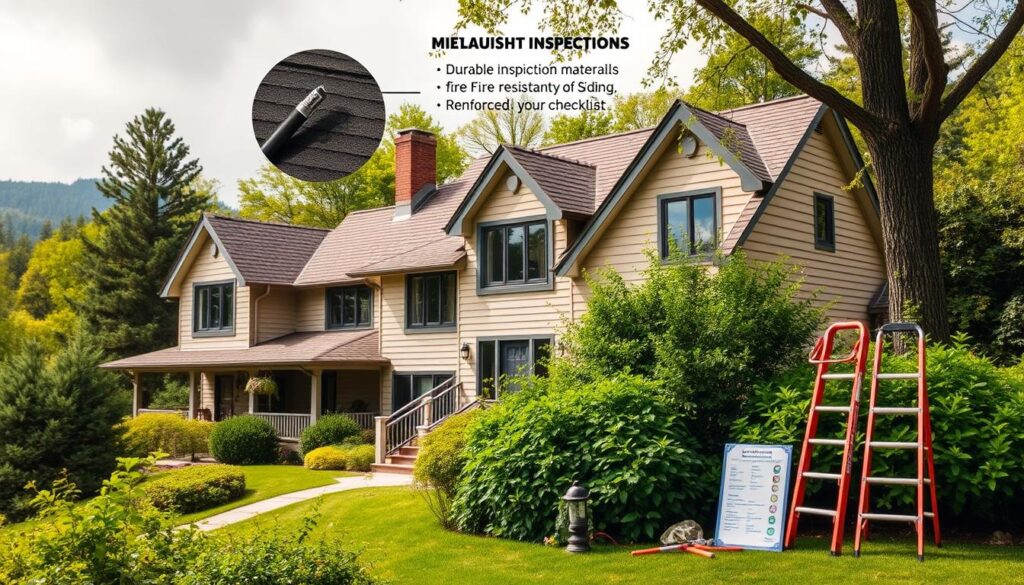
Even the strongest fire resistant homes need regular checks. Keeping gutters and rooflines clear of dry debris helps prevent ember spread. Simple steps can make a big difference in keeping your home safe.
Scheduling Professional Assessments
Experts can spot problems like structural flaws or worn coatings before they become serious. These visits can reduce fire risks by 25%. They also make sure fireproof materials stay in good condition. Small issues can quickly turn into big problems if not caught early.
DIY Maintenance to Reduce Fire Risk
Homeowners can check for cracks and clean vents or filters to keep their homes safe. Clearing leaves and brush around the house helps too. Doing these tasks regularly can save money and give you peace of mind.
- Test smoke alarms monthly.
- Inspect windows, doors, and doorframes for wear.
- Trim shrubs and clear dry foliage around exterior walls.
| Task | Frequency | Benefit |
|---|---|---|
| Gutter Cleanup | Every Month | Prevents ember buildup |
| Fireproof Coating Check | Twice a Year | Preserves structural integrity |
| Seals & Caulking Inspection | Annually | Reduces smoke infiltration |
Wildfire-Proof Home Tips and Best Practices
Using Class A-rated roofing materials with noncombustible layers helps protect against wind-blown embers. Clay brick, metal framing, and concrete foundations make your home more fire resistant. Many ask, is it possible to build a fireproof house? Choosing materials that can handle extreme heat is a good start. But, taking proactive steps is even more important.
Ember-proofing eaves and vents stops sparks from getting into attics and walls. Keeping a safe area around your home reduces dry plants where fires can start. Heat resistant homes need regular roof and gutter cleanings to remove debris. This reduces the risk of fires by removing fuel for embers.
Having a solid exit plan is wise in fire-prone areas. Adding sprinkler systems with a dedicated water source adds more protection. Fire resistant building design and proven safety measures can greatly improve a home’s chances of surviving a fire.
- Trim or clear dry brush within at least 30 feet of the structure
- Use noncombustible siding and deck materials
- Install multi-pane windows or fireproof shutters
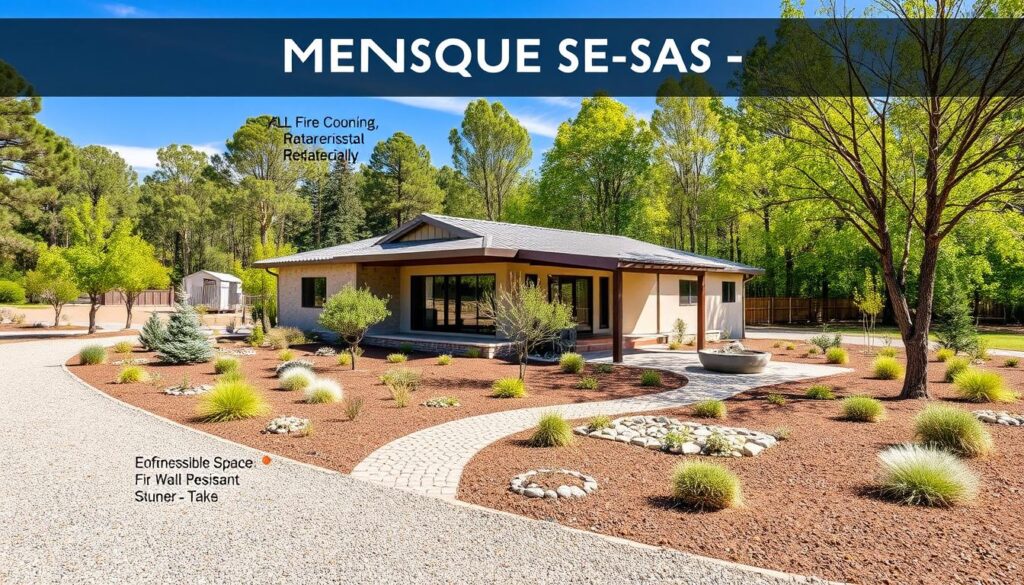
| Recommended Safe Zone | Environment | Key Material Tip |
|---|---|---|
| 30 Feet | Less Wooded Area | Maintain irrigated gravel or concrete buffer |
| 50 Feet | Moderately Wooded | Remove excess vegetation and dry branches |
| 100 Feet | High-Risk Regions (e.g. California) | Use Class A-rated roofing and 1/8-inch vent mesh |
Eco-Friendly Approaches to Building a Fire-Safe Dwelling
Protecting a home from fires can also help the environment. Modern homes use sustainable materials and designs. They use recycled steel and concrete to cut down waste and increase safety.
Clay bricks, made at high heat, keep pests out and withstand high temperatures. This mix of green building and fire safety technology offers strong insulation and lowers carbon emissions.
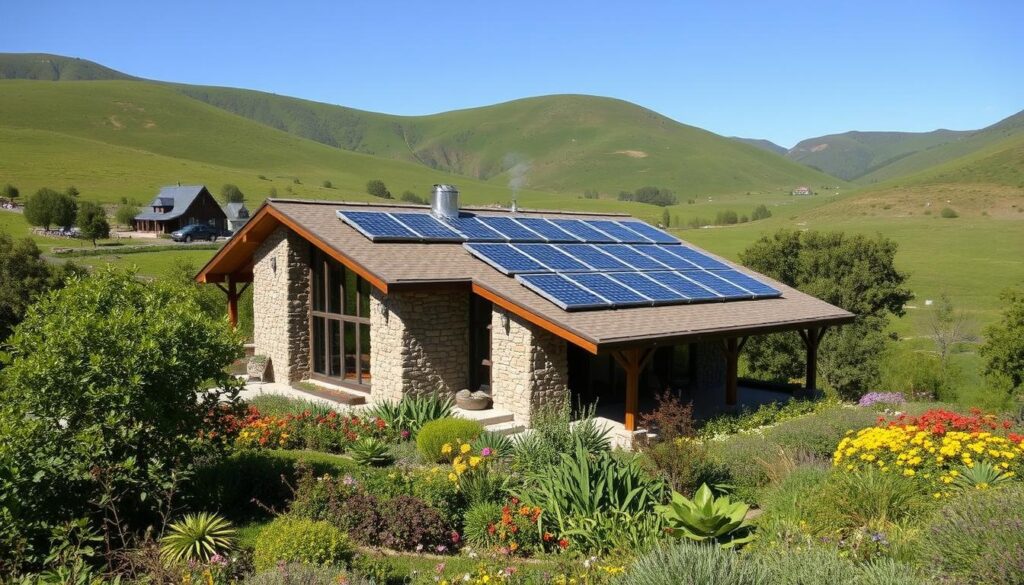
Adding solar panels or renewable systems can lower energy bills. Using low-VOC fire-retardant coatings on wood adds extra protection. These methods help keep homes safe by directing embers away from dangerous areas.
Sustainable Materials That Resist High Temperatures
Fire safety isn’t just about walls and roofs. It also includes keeping important documents safe. There are many fireproof safes available at discounted prices.
Gardall offers up to $502.75 off, and AMSEC has discounts of up to $2,141.25 on certain models. Hollon and Phoenix also have deals for protecting your valuables. RPNB’s Deluxe Biometric models are modern and affordable, with up to $102.00 off.
There are 164 fireproof safes ready to ship. Each one has a high fire rating, protecting your belongings for at least an hour.
Budgeting and Cost Considerations for Fire-Resistant Construction
Planning the budget for a fire-resistant building can seem daunting. Some materials are pricier but need less repair over time. You might also save on insurance, as many providers offer lower rates for stronger fire protection.
Costs depend on the size and purpose of the project. Prices start at $2 per square foot and can go up to $12 for special treatments. Here are some examples:
- Office buildings: $3 – $8 per square foot
- Retail stores: $2 – $6 per square foot
- Industrial facilities: $5 – $12 per square foot
- Warehouses: $4 – $10 per square foot
- Healthcare facilities: $6 – $12 per square foot
Materials like spray-applied fire-resistive solutions or cementitious coatings are on the lower side. More advanced options like intumescent coatings or fireproof boards are pricier. Finding the right balance can save a lot if a fire happens in the future.
Owners of fire-resistant homes and buildings face fewer repairs and less smoke damage. This reduces financial stress and boosts safety. Fire-resistant buildings also protect families and their belongings, giving them peace of mind.
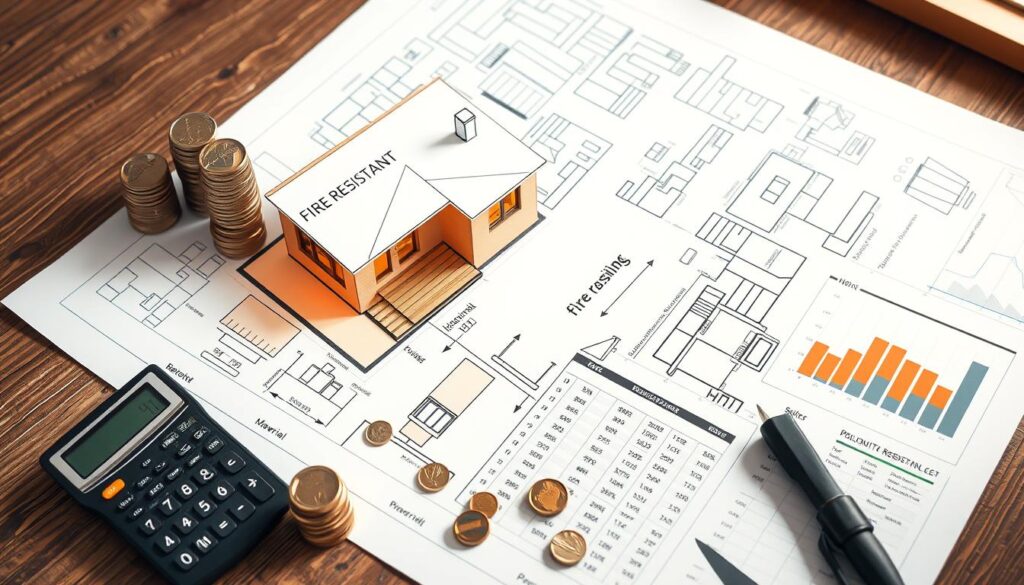
Working with Contractors on Fire-Resistant Building Designs
Working with experts in fireproof design gives you peace of mind. They know local challenges and build strong structures. They also keep up with building codes for fire safety.
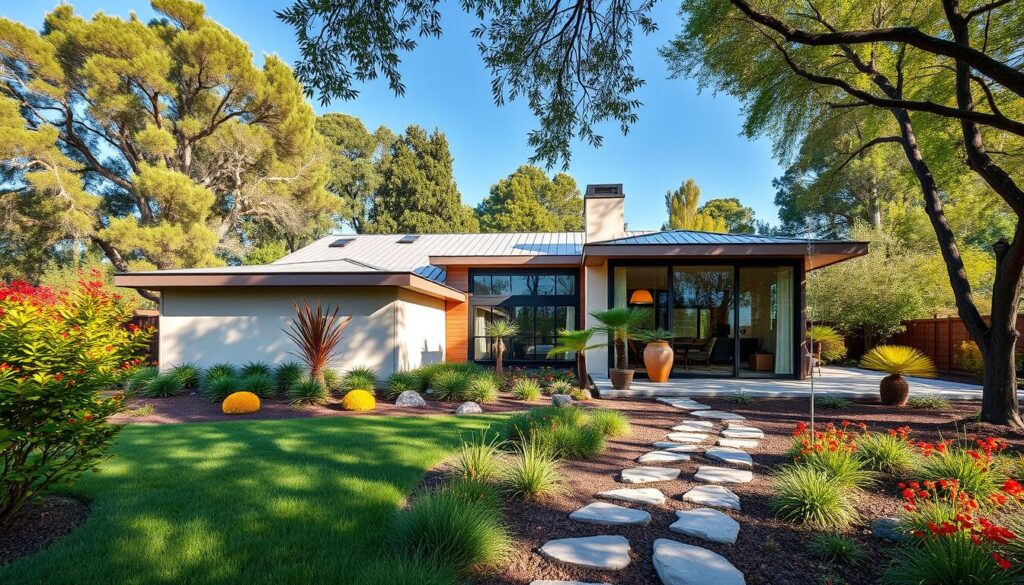
Experts say a single brick can handle up to 1200°C, while steel beams weaken at 600°C. This knowledge helps contractors make houses more fire-resistant. They use advanced insulation and ensure all openings are safe.
Selecting Experienced Professionals for Fire Protection
Homeowners look for teams with a track record in fireproofing. Certified contractors use temperature guidelines for materials. Their careful work makes your home safer from foundation to roof.
| Key Tip | Outcome |
|---|---|
| Sealed Eaves and Screened Vents | Blocks wind-driven embers |
| Non-Combustible Siding | Helps halt exterior flames |
| Fire-Rated Insulation | Slows heat transfer |
Common Mistakes to Avoid in Fire Protection for Homes
Using just one way to protect your home is too risky. You need regular updates and careful planning for true peace of mind. Using fireproof housing materials creates a strong defense against fires. Also, watching for small problems helps keep your home safe and cozy.
Look closely at every opening in your home. A 2014 study found that embers sneak in through small gaps before the main fire. This means even strong walls can fail if small gaps are left open.
Overlooking Vent and Gap Sealing
Vents, crawlspaces, and attic hatches can let sparks in. Making sure they are sealed well helps. Regular checks on these seals keep your home safe from embers and fire risks.
Ignoring Regional Fire Hazard Trends
Every area faces different fire dangers. Not adapting to these risks can weaken your home’s defense. In areas prone to wildfires, extra steps can make your home safer and more secure.
Conclusion
Using non-combustible materials and ember-resistant details is key for fireproofing houses. Metal roofs can last up to 80 years, and clay tiles can last over a century. Fiber cement or brick siding can last for decades, offering peace of mind against embers.
This strategy, along with narrower eaves and double-paned windows, helps prevent sparks from entering. Fireproofing a house is not a one-time task. It requires regular upkeep, like clearing gutters to avoid debris fires.
Smart irrigation systems and drought-resistant plants protect your lawn from fires. Also, check seals around doors and vents to keep embers out. While fireproof designs may cost more upfront, they save money on repairs and replacements in the long run.
Fire-resistant architecture worked well during the 2017 Thomas Fire. A home in Ojai, built with noncombustible materials, suffered little damage. By staying informed about fire risks, scheduling maintenance, and investing in upgrades, families can protect their homes. This approach ensures fireproofing efforts last for years to come.

